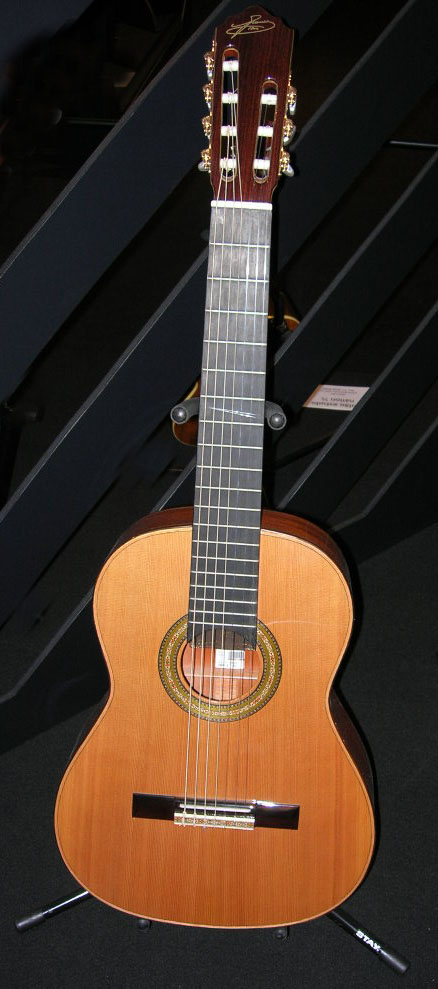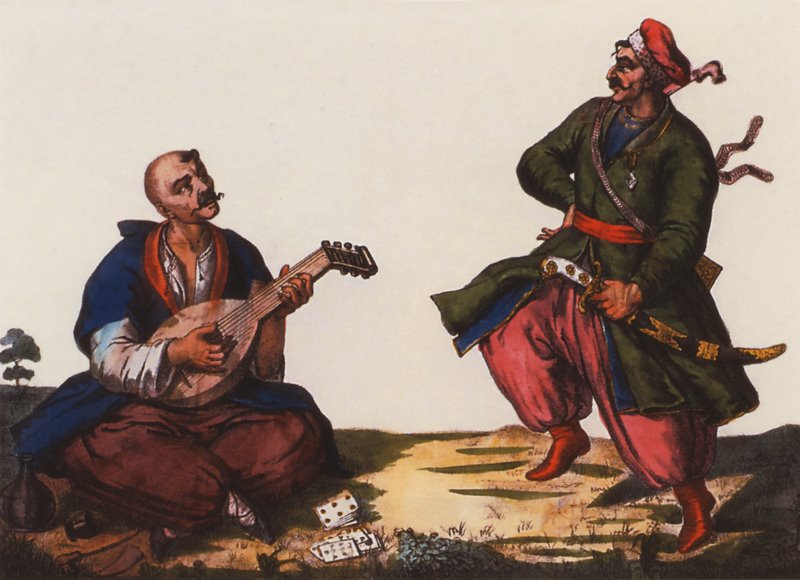|
Seven-string Guitar
The seven-string guitar adds one additional string to the more common six-string guitar, commonly used to extend the bass range (usually a low B) or also to extend the treble range. The additional string is added in one of two different ways: by increasing the width of the fingerboard such that the additional string may be fretted by the left hand; or, by leaving the fingerboard unchanged and adding a "floating" bass string. In the latter case, the extra bass string lies next to the existing bass strings, but free of the fingerboard in similar fashion as the archlute and theorbo. Such unfrettable bass strings were historically known as diapasons or bourdons. Some types of seven-string guitars are specific to certain cultures such as the Russian guitar, Russian, Guitarra séptima, Mexican, and Brazilian guitars. History The history of the seven-string guitar stretches back more than 230 years. During the Renaissance period (), the European guitar generally had four course (mus ... [...More Info...] [...Related Items...] OR: [Wikipedia] [Google] [Baidu] |
Melbourne Conservatorium Of Music
The Melbourne Conservatorium of Music is the music school at the University of Melbourne and part of the Faculty of Fine Arts and Music, University of Melbourne, Faculty of Fine Arts and Music. It is located near the Melbourne City Centre on the Southbank campus of the University of Melbourne. Degree programs specialising in music performance, Musical composition, composition, musicology, ethnomusicology, interactive composition, jazz and improvisation, conducting, pedagogy and music therapy are taught at the Conservatorium, which also runs an Early Music Studio, and oversees the publishing house Lyrebird Press. It offers graduate programs including certificates and diplomas, and research and coursework awards at the masters and doctoral levels. History The teaching of music at the University of Melbourne has been undertaken under a number of administrative structures. The first award of a degree in music (a Bachelor of Music) was recorded in 1879, and the first Chair of Music, en ... [...More Info...] [...Related Items...] OR: [Wikipedia] [Google] [Baidu] |
Bard (Soviet Union)
The term bard ( rus, бард, p=bart) came to be used in the Soviet Union in the early 1960s, and continues to be used in Russia today, to refer to singer-songwriters who wrote songs outside the Soviet establishment, similarly to folk singers of the American folk music revival. Because in bard music songwriters perform their own songs, the genre is also commonly referred to as author song (, ''avtorskaya pesnya'') or bard song (, ''bardovskaya pesnya''). Bard poetry differs from other poetry mainly in being sung with simple guitar accompaniment, as opposed to being spoken. Another difference is that it focuses less on style and more on meaning. This means that fewer stylistic devices are used, and the poetry is often in the form of a narrative. What separates bard poetry from other songs is that the music is far less important than the lyrics; chord progressions are often very simple and tend to repeat from one bard song to another. A far more obvious difference is the comm ... [...More Info...] [...Related Items...] OR: [Wikipedia] [Google] [Baidu] |
Arpeggio
An arpeggio () is a type of Chord (music), chord in which the Musical note, notes that compose a chord are individually sounded in a progressive rising or descending order. Arpeggios on keyboard instruments may be called rolled chords. Arpeggios may include all notes of a musical scale, scale or a partial set of notes from a scale, but must contain notes of at least three Pitch (music), pitches (two-pitch sequences are known as Trill (music), trills). Arpeggios may sound notes within a single octave or span multiple octaves, and the notes may be sustained and overlap or be heard separately. An arpeggio for the chord of C major going up two octaves would be the notes (C, E, G, C, E, G, C). In musical notation, a very rapid arpeggiated chord may be written with a wavy vertical line in front of the chord. Typically these are read as to be played from the lowest to highest note, though composers may specify a high to low sequence by adding an arrow pointing down. Arpeggios ... [...More Info...] [...Related Items...] OR: [Wikipedia] [Google] [Baidu] |
Harp
The harp is a stringed musical instrument that has individual strings running at an angle to its soundboard; the strings are plucked with the fingers. Harps can be made and played in various ways, standing or sitting, and in orchestras or concerts. Its most common form is triangular in shape and made of wood. Some have multiple rows of strings and pedal attachments. Ancient depictions of harps were recorded in Mesopotamia (now Iraq), Persia (now Iran) and Egypt, and later in India and China. By medieval times harps had spread across Europe. Harps were found across the Americas where it was a popular folk tradition in some areas. Distinct designs also emerged from the African continent. Harps have symbolic political traditions and are often used in logos, including in Ireland. Historically, strings were made of sinew (animal tendons). Other materials have included gut (animal intestines), plant fiber, braided hemp, cotton cord, silk, nylon, and wire. In pedal harp scor ... [...More Info...] [...Related Items...] OR: [Wikipedia] [Google] [Baidu] |
Soviet Union
The Union of Soviet Socialist Republics. (USSR), commonly known as the Soviet Union, was a List of former transcontinental countries#Since 1700, transcontinental country that spanned much of Eurasia from 1922 until Dissolution of the Soviet Union, it dissolved in 1991. During its existence, it was the list of countries and dependencies by area, largest country by area, extending across Time in Russia, eleven time zones and sharing Geography of the Soviet Union#Borders and neighbors, borders with twelve countries, and the List of countries and dependencies by population, third-most populous country. An overall successor to the Russian Empire, it was nominally organized as a federal union of Republics of the Soviet Union, national republics, the largest and most populous of which was the Russian SFSR. In practice, Government of the Soviet Union, its government and Economy of the Soviet Union, economy were Soviet-type economic planning, highly centralized. As a one-party state go ... [...More Info...] [...Related Items...] OR: [Wikipedia] [Google] [Baidu] |
Gutheil
Gutheil is a German surname of: * Emil Arthur Gutheil (1889–1959), Polish-American psychiatrist * (1868–1914), German conductor and composer, husband of Marie Gutheil-Schoder * Marie Gutheil-Schoder (1874–1935), German soprano * (born 1959), German jurist See also * Gutheil (publisher), founded in 1859 by Alexander Bogdanovich Gutheil, later an imprint of Serge Koussevitzky's Editions Russes {{surname, Gutheil German-language surnames ... [...More Info...] [...Related Items...] OR: [Wikipedia] [Google] [Baidu] |
Andrei Sychra
Andrei Osipovich Sychra (Sikhra, Sichra, in Russian Андрей Осипович Сихра ''Andrej Osipovič Sixra'') (born 1773 (?1776) in Vilnius; died November 21/December 3, 1850, in St Petersburg) was a Russian guitarist, composer and teacher of Czech ancestry. Sychra holds a prominent position within Russia, where he is often referred to as the patriarch of the seven-string guitar, and also as its inventor, disputed though that may be. He was a major force in the development of Russian guitar music and one of its most prolific composers, as well as an important teacher who trained a number of students. Sychra initially played the harp and possibly the torban on which he was reputed to have been a great virtuoso, before dedicating himself to the seven-string guitar. He moved to Moscow early in 1801, and became the dominant figure in the field, gaining a huge following. In 1812, perhaps because of Napoleon’s campaign and the Moscow fire of that year, he moved to St Pete ... [...More Info...] [...Related Items...] OR: [Wikipedia] [Google] [Baidu] |
Torban
The torban (, also ''teorban'' or ''Ukrainian theorbo'') is a Ukrainian musical instrument that combines the features of the Baroque lute with those of the psaltery. The Тorban differs from the more common European bass lute known as the theorbo in that it had additional short unfretted treble strings (known as '' prystrunky'') strung along the treble side of the soundboard. Overview It appeared in the second quarter of the 18th century, probably influenced by the central European Theorbo and the Angelique which, according to Ukrainian sources Cossack mercenaries would have encountered in the Thirty Years' War. According to Marcin Ludwicki and Roman Turovsky, the torban's inventor was Tuliglowski, a Paulite monk from Jasna Gora, who designed the instrument between 1736 and 1740. The Torban was manufactured and used mainly in Ukraine, but also occasionally encountered in neighbouring Poland and Russia (only 3 luthiers could be identified from the surviving instruments). T ... [...More Info...] [...Related Items...] OR: [Wikipedia] [Google] [Baidu] |
Kobza
The kobza (), also called bandura () is a Ukrainian folk music instrument of the lute family (Hornbostel-Sachs classification number 321.321-5+6), a relative of the Central European mandora. The term ''kobza'' however, has also been applied to a number of other Eastern European instruments distinct from the Ukrainian kobza. Construction The Ukrainian kobza was a traditionally gut-strung, lute-like stringed musical instrument with a body hewn from a single block of wood. Instruments with a staved assembly also exist. The kobza has a medium-length neck which may or may not have tied-on frets, which were usually made of gut. It was single-strung (sometimes also double-strung) and the strings were played with fingertips or occasionally with a plectrum threaded through a ring placed on the middle finger. History The term kobza is of Turkic languages, Turkic origin and is related to the terms kobyz and komuz, thought to have been introduced into the Ukrainian language in the 13th ce ... [...More Info...] [...Related Items...] OR: [Wikipedia] [Google] [Baidu] |
Cittern
The cittern or cithren ( Fr. ''cistre'', It. ''cetra'', Ger. ''Cister,'' Sp. ''cistro, cedra, cítola'') is a stringed instrument dating from the Renaissance. Modern scholars debate its exact history, but it is generally accepted that it is descended from the medieval citole (or cytole). Its flat-back design was simpler and cheaper to construct than the lute. It was also easier to play, smaller, less delicate and more portable. Played by people of all social classes, the cittern was a popular instrument of casual music-making much like the guitar is today. History Pre-modern citterns The cittern is one of the few metal-strung instruments known from the Renaissance music period. It generally has four courses of strings (single, pairs or threes depending on design or regional variation), one or more courses being usually tuned in octaves, though instruments with more or fewer courses were made. The cittern may have a range of only an octave between its lowest and highest st ... [...More Info...] [...Related Items...] OR: [Wikipedia] [Google] [Baidu] |



